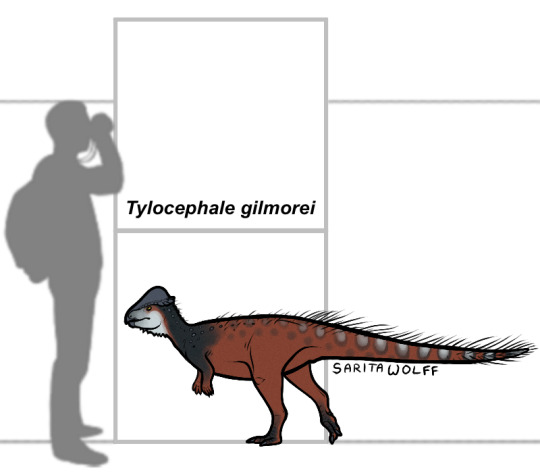#Khulsanurus
Text

#Archovember Day 25 - Tylocephale gilmorei
The pachycephalosaurids are famous for their thick, armoured heads, but one dome rose above the rest. Living in Late Cretaceous Mongolia, Tylocephale gilmorei, while a medium-sized pachycephalosaur, had the tallest known dome head comparable to body size. This dome could sustain higher forces of impact than other pachycephalosaurids. Like other pachycephalosaurs it likely ate plants and insects, though it had serrations on its teeth that may have allowed it to eat tougher materials like seeds and nuts.

Tylocephale lived in an arid alluvial plain. It lived alongside a variety of other dinosaurs in the Barun Goyot Formation including ankylosaurs like Saichania, Tarchia, and Zaraapelta, protoceratopsids like Bagaceratops and Breviceratops, the titanosaur Quaesitosaurus, dromaeosaurs like Kuru and Shri, halszkaraptorines like Hulsanpes, oviraptorids like Conchoraptor, Heyuannia, and Nemegtomaia, alvarezsaurids like Khulsanurus and Parvicursor, and birds like Gobipipus, Gobipteryx, and Hollanda.
#my art#SaritaDrawsPalaeo#Tylocephale gilmorei#Tylocephale#pachycephalosaurs#pachycephalosaurids#ornithischians#dinosaurs#archosaurs#archosauromorphs#Archovember#Archovember2023
17 notes
·
View notes
Text
Khulsanurus magnificus Averianov & Lopatin, 2021 (new genus and species)

(Type specimen of Khulsanurus magnificus, from Averianov and Lopatin, 2021)
Meaning of name: Khulsanurus = Khulsan tail; magnificus = magnificent
Age: Late Cretaceous (Campanian–Maastrichtian?)
Where found: Barun Goyot Formation, Ömnögov, Mongolia
How much is known: Partial skeleton of one individual, including parts of the forelimbs, vertebrae, and hips.
Notes: Khulsanurus was an alvarezsaurid, a group of unusual, small-bodied theropods with short but powerful forelimbs, each tipped with an enlarged thumb claw. They are generally thought to have been insectivores that used their forelimbs to break open rotting wood and other hard substrates in search of prey.
Khulsanurus is known from the same locality as another genus of alvarezsaurid, Parvicursor. The two were probably relatively closely related, but differed from each other in the shape of their vertebrae.
Reference: Averianov, A.O. and A.V. Lopatin. 2021. The second taxon of alvarezsaurid theropod dinosaurs from the Late Cretaceous Khulsan locality in Gobi Desert, Mongolia. Historical Biology advance online publication. doi: 10.1080/08912963.2021.2000976
26 notes
·
View notes